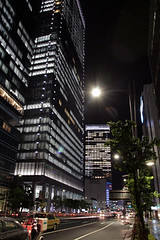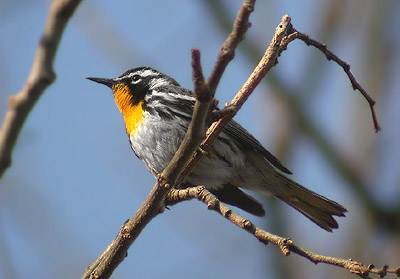
Yellow-throated Warbler - Record Early for Wisconsin
I've been reading with interest the discussion thread "An alternative to field notes?" on the ID-Frontiers listserv. At debate is the question (or impression) that digiscoping/digital photography may be replacing detailed note taking in the field (if that's the case then there are more digiscopers than I thought):
"Let's face it - note-taking and field sketching are a matter of personal priority/interest. I got into birding as a photographer and have at various times over the past 30 years resolved to keep field notes. After a few (days/weeks/months) those good intentions always returned to hibernation. Now I digiscope." - C. Taylor
"Not all reports need detailed field notes. If there are great photos of the thing, which are diagnostic, well many people on a committee will look at the photos and go no further before accepting." - A. Jaramillo
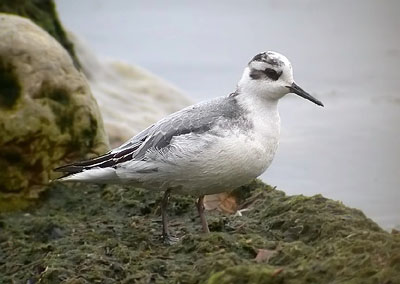
Red Pharalope - WSO Record #2005-072
Even an aesthetically good photograph won't guarantee that a records committee will accept a rare bird sighting. I've only ever had one rejection - the December 24th mystery swallows of 2001 at Nine Springs. Though I had fairly nice close-up shots (not digiscoped) of two nearly frozen juvenile swallows, they were back-angled views that didn't reveal quite enough to separate Tree from Northern Rough-winged or Bank Swallow. And whoopsie...I didn't make any field notes of their behavior! One member of ID-Frontiers seemed quite disappointed writing, "Do you mean a lone observer photographed two out-of-date-and-place swallows and took no notes of the sighting...just these five photos?"
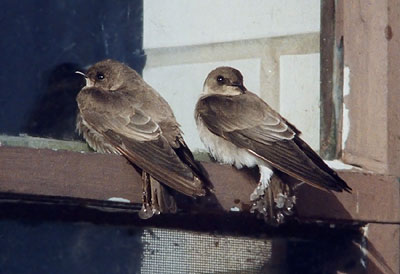
Mystery Swallows - NOT ACCEPTED!
The pictures were submitted in early 2002 and believe or not, it took until just this past spring for WSO to reach a consensus, or rather lack thereof. Jim Frank, WSO Records Committee chair, closed his letter to me with the following paragraph:
"Bottom line, there just doesn't seem to be a consistent match of the field marks we have from the photos. If you have access to Birding, Vol. 28, No. 2, pp 111-116, from April 1986, some of the information there as well as the photographs may help you see we were left a bit confused. Even though the photographs were amazing, sometimes there just isn't enough to go on."
In a few ID Frontiers posts I began to detect a purist mentality when it comes to taking field notes. There's quite a bit of rhetoric about honing the skill, elevating it to a seemingly infallible capability when it comes to making an identification. The obvious implication to me was that digiscoping/digital photography doesn't quite match up as a potential bird identification discipline:
"I had in mind - the practice of note-taking improves and strengthens ones ability to see, describe, and communicate details with the wider community of birders. I'm not the best or most diligent at notes. Nevertheless, steadily practicing it, forcing myself to 'see' more and to see more accurately only came with note taking. This improvement in ability means that one's contributions are more lasting and more valuable. As humans, we all have extraordinary perceptual capacity. But it takes time and practice to hone those senses and to hone our ability to see and describe birds. More importantly, it takes time and experience to learn when those sense fail or fool us. Many people bird for their own enjoyment, and that is fine. Any photo or video is better than nothing in that case." - L. Bevier
"What I've come to realize, however, is that most birders will never take field notes, not on paper, not into a recording device. Note taking is data collection and data collection is just too sciency. Most folks just don't approach the hobby the way the great amateur naturalists of the 19th and early 20th century did. Most folks don't recognized the participatory possibilities in contributing data to the commons." - M. Patterson
"If you really want to ratchet up your skills at observation and recollection of what birds look like, take notes. If you want to ratchet it up two notches, draw pictures. Nothing forces you to look as closely as by drawing." - A. Jaramillo
Sure, I really blew it on the 2001 December swallows and I vowed something like that would never happen again. But the dedicated photographer cannot afford to divert his/her attention to writing things down in a notebook as opportunities can be fleeting. This was the case with the Midwest Cave Swallow invasion last fall. I had only seconds to get a shot off under very challenging circumstances and logistics, but I got my bird and it was clearly identifiable:
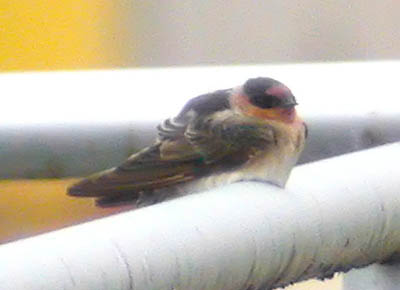
Cave Swallow - WSO Record #2005-084
"Mike, thank you for the very identifiable shot of the Cave Swallow! I was there last Monday and had good looks but the little buggers never perched. Glad you were able to get the shot that should help establish the first state record. " - M. Korducki
Documenting and submitting a written report of a rare bird sighting from field notes is a form of persuasive writing - you're building a case for an observation. But anyone reviewing the report begins from that impression and bias. With a photograph, each person who studies the picture can start from the exact same raw data - a physical representation of the observation.
Naturally, the quality of a written report (or image) will be reflected by the skill and talent of the observer (or field craft of the photographer) thus rendering a strong/weak report or a great/poor image. But all the salient points made with regard to accurate and skillful note taking cited by various seasoned ornithologists and birders - time, dedication and experience - are not unfamiliar notions to high-level digiscopers and bird photographers.
All images © 2006 Michael McDowell






